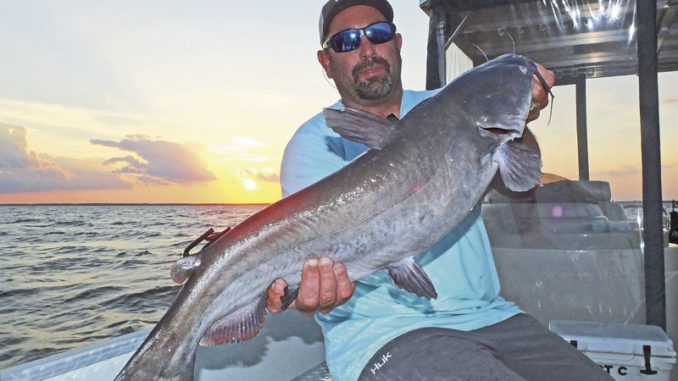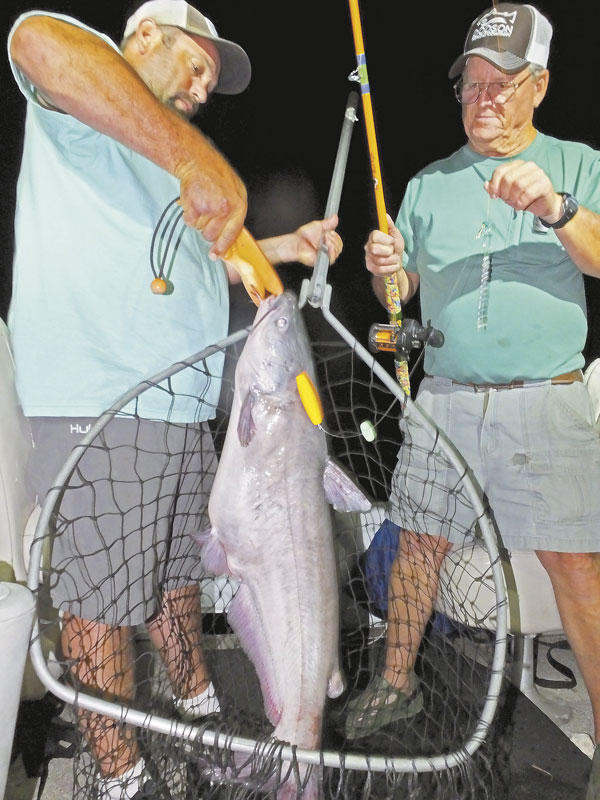
Keep cool, gaze at the stars, catch catfish
It’s August and it’s hot everywhere in the Carolinas. High temperatures and humidity are bummers. But you can still beat the midsummer blues by heading for the water after catfish.
Specifically, you can go to the Santee Cooper lakes and catch big blue catfish at night.
Catfish guide Steve Howard said he fishes day or night trips during the summer, but the nocturnal hours certainly provide advantages.
Why fish at night during August
Howard said fishing during the dark hours can be productive anytime of the year but the summer feeding patterns can be very consistent.
“Catfish, mostly blues but flatheads too, move shallow to feed at night and active, feeding catfish are my targets,” he said.
Howard (336-421-5313) guides out of Blacks Camp (843-753-2231) located on the Diversion Canal. He generally fishes Lake Moultrie but said both lakes are productive.
The lower air temperature is a plus in terms of comfort and enhances the enjoyment of the fishing trip, he said. Also, because of the proximity of the lakes to the coast and the sheer size of the Santee Cooper lakes, a reliable breeze often develops.
“A steady breeze pushes forage into downwind locations,” Howard said. “Food motivates catfish and during the summer catfish feed heavily so I target food sources. The food may be species such as threadfin shad, gizzard shad and white perch. Another good bet for August is fishing mussel beds.”
Downwind points, humps, coves, pockets, ledges and depressions leading to shallow water are all potentially prime nocturnal hotspots.

How to find the right stuff
Howard gets on the water before dark, usually an hour or more before sunset.
“Fish patterns change as forage moves. So this gives me time to determine the daily pattern,” he said. “I’ll graph places where I’ve had success recently, looking for forage and catfish signals on the graph. I prefer to see catfish off the bottom, not hugging it, because, hopefully that means they’re active.”
When he finds an area with promising signs, he’ll often set up a course to drift-fish over skinny water areas that are possible nocturnal targets. He likes to drift up a slope, over a hump and back down the other side. Often one side or the other will produce fish.
“I love to catch a couple of quality fish before dark because that means we should be in the right area,” he said. “Also, that clues me in to where, and how, I need to fish after dark. Because drifting or fishing from an anchored setup can be effective.”
Catfish techniques for success
Howard said he’ll make a decision before dark whether to anchor or drift fish.
“Both techniques are productive during August. And often, the decision is based on my sense of what the fish are going to do, as well as the weather pattern for that specific evening,” he said. “If fish are in the area and they’re likely to move shallow, I’ll get anchored and set up before dark.”
Howard said defining shallow water for fishing is not about a specific number in terms of the depth to fish.
“If I’m going to fish shallow, I’ll target the shallowest water in the area where fish are active,” he said. “It may be 5 feet deep or it may be 15 feet deep. Doesn’t matter to me as long as quality catfish show up.”
He said when anchoring, he get rigs baited and cast out before dark. He’ll fan cast rigs around the boat to saturate the shallowest water and down a slope toward nearby deeper water that catfish use as travel routes.
Patience!
“Often, we’ll catch some good fish before dark, and right at sunset can be prime,” he said. “But it can be a game of patience too, and they may not turn on until well after dark.”
“If I’m on a good drift-fishing bite prior to dark, catching multiple fish each drift, I’m not going to leave biting fish to go anchor,” he said. “Drifting is an awesome nighttime technique. I may have to adapt and drift shallower water as it gets darker. But if I’m on biting fish I stay on them. If action slows and I think they’ve scattered in the shallows, then I can anchor and fish that target after dark.
Bait is always a key for catfish. And his summertime favorites are white perch and blueback herring.
“Bait size is important and I’ll fish some big baits. But I typically use smaller baits this time of the year and they produce big fish,” he said. “Mussel beds are excellent targets. And it’s common to see mussel shells floating during August. When I see this, I know catfish are eating mussels. So I’ll downsize my baits to match the small chunks of mussel meat that catfish consume.”
Head to Santee Cooper and beat the heat while putting those midsummer blues in the cooler.





Be the first to comment